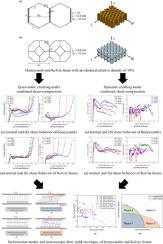当前位置:
X-MOL 学术
›
Int. J. Impact. Eng.
›
论文详情
Our official English website, www.x-mol.net, welcomes your
feedback! (Note: you will need to create a separate account there.)
Crushing behavior of honeycomb vs. foam under combined shear-compression loading
International Journal of Impact Engineering ( IF 5.1 ) Pub Date : 2020-12-01 , DOI: 10.1016/j.ijimpeng.2020.103696 Yu Duan , Zhiyong Liu , Xianhang Zhao , Naidan Hou , Bing Du , Huifang Liu , Zhenqiang Zhao , Bing Hou , Yulong Li , Lev N. Rabinskiy
International Journal of Impact Engineering ( IF 5.1 ) Pub Date : 2020-12-01 , DOI: 10.1016/j.ijimpeng.2020.103696 Yu Duan , Zhiyong Liu , Xianhang Zhao , Naidan Hou , Bing Du , Huifang Liu , Zhenqiang Zhao , Bing Hou , Yulong Li , Lev N. Rabinskiy

|
Abstract This paper conducts a combined compression-shear test on honeycombs and Kelvin foams to compare their yield envelopes. The honeycomb and foam specimens with a similar relative density are fabricated by using the additive manufacturing technique. The quasi-static and dynamic crushing behaviors under combined shear-compression are investigated by employing a universal testing machine and a rotatable Hopkinson bar system, respectively. Five loading angles ranging from 0° to 50° are considered. Results reveal that the normal strengths of both honeycomb and Kelvin foam decrease while the shear strengths increase with the loading angle increasing. Moreover, honeycombs change the deformation mode from the progressive folding mode to the global rotation mode while Kelvin foams maintain the layered folding mode as the loading angle increases. Therefore, honeycombs show the normal strength decreasing more sharply than Kelvin foams. As a result, although honeycombs possess higher normal strengths than Kelvin foams under pure compression, the difference becomes smaller with the increase of loading angle. There is a cross point on the macroscopic yield envelopes of honeycomb and Kelvin foam. At this point, honeycomb and Kelvin foam possess the same normal and shear strengths. Moreover, the dynamic yield envelopes of both honeycombs and Kelvin foams possess an almost isotropic expansion of quasi-static envelopes due to the loading rate effect. These yield envelopes provide design criteria for cellular materials to withstand any applied shear and compressive stress state.
中文翻译:

复合剪切压缩载荷下蜂窝与泡沫的破碎行为
摘要 本文对蜂窝和开尔文泡沫进行了组合压缩-剪切试验,以比较它们的屈服包络。具有相似相对密度的蜂窝和泡沫试样是通过使用增材制造技术制造的。分别采用万能试验机和可旋转的霍普金森杆系统研究了组合剪切压缩下的准静态和动态破碎行为。考虑了从 0° 到 50° 的五个加载角度。结果表明,随着加载角的增加,蜂窝和开尔文泡沫的法向强度均降低,而剪切强度增加。此外,蜂窝将变形模式从渐进折叠模式转变为全局旋转模式,而开尔文泡沫随着加载角度的增加保持分层折叠模式。因此,蜂窝显示正常强度比开尔文泡沫更急剧地下降。因此,尽管蜂窝在纯压缩下具有比开尔文泡沫更高的法向强度,但随着加载角的增加,差异变小。蜂窝和开尔文泡沫的宏观屈服包络上有一个交叉点。此时,蜂窝和开尔文泡沫具有相同的法向强度和剪切强度。此外,由于加载速率效应,蜂窝和开尔文泡沫的动态屈服包络都具有准静态包络的几乎各向同性膨胀。这些屈服包络为蜂窝材料提供了承受任何施加的剪切和压缩应力状态的设计标准。虽然蜂窝在纯压缩下比开尔文泡沫具有更高的法向强度,但随着加载角的增加,差异变小。蜂窝和开尔文泡沫的宏观屈服包络上有一个交叉点。此时,蜂窝和开尔文泡沫具有相同的法向强度和剪切强度。此外,由于加载速率效应,蜂窝和开尔文泡沫的动态屈服包络都具有准静态包络的几乎各向同性膨胀。这些屈服包络为蜂窝材料提供了承受任何施加的剪切和压缩应力状态的设计标准。虽然蜂窝在纯压缩下比开尔文泡沫具有更高的法向强度,但随着加载角的增加,差异变小。蜂窝和开尔文泡沫的宏观屈服包络上有一个交叉点。此时,蜂窝和开尔文泡沫具有相同的法向强度和剪切强度。此外,由于加载速率效应,蜂窝和开尔文泡沫的动态屈服包络都具有准静态包络的几乎各向同性膨胀。这些屈服包络为蜂窝材料提供了承受任何施加的剪切和压缩应力状态的设计标准。此时,蜂窝和开尔文泡沫具有相同的法向强度和剪切强度。此外,由于加载速率效应,蜂窝和开尔文泡沫的动态屈服包络都具有准静态包络的几乎各向同性膨胀。这些屈服包络为蜂窝材料提供了承受任何施加的剪切和压缩应力状态的设计标准。此时,蜂窝和开尔文泡沫具有相同的法向强度和剪切强度。此外,由于加载速率效应,蜂窝和开尔文泡沫的动态屈服包络都具有准静态包络的几乎各向同性膨胀。这些屈服包络为蜂窝材料提供了承受任何施加的剪切和压缩应力状态的设计标准。
更新日期:2020-12-01
中文翻译:

复合剪切压缩载荷下蜂窝与泡沫的破碎行为
摘要 本文对蜂窝和开尔文泡沫进行了组合压缩-剪切试验,以比较它们的屈服包络。具有相似相对密度的蜂窝和泡沫试样是通过使用增材制造技术制造的。分别采用万能试验机和可旋转的霍普金森杆系统研究了组合剪切压缩下的准静态和动态破碎行为。考虑了从 0° 到 50° 的五个加载角度。结果表明,随着加载角的增加,蜂窝和开尔文泡沫的法向强度均降低,而剪切强度增加。此外,蜂窝将变形模式从渐进折叠模式转变为全局旋转模式,而开尔文泡沫随着加载角度的增加保持分层折叠模式。因此,蜂窝显示正常强度比开尔文泡沫更急剧地下降。因此,尽管蜂窝在纯压缩下具有比开尔文泡沫更高的法向强度,但随着加载角的增加,差异变小。蜂窝和开尔文泡沫的宏观屈服包络上有一个交叉点。此时,蜂窝和开尔文泡沫具有相同的法向强度和剪切强度。此外,由于加载速率效应,蜂窝和开尔文泡沫的动态屈服包络都具有准静态包络的几乎各向同性膨胀。这些屈服包络为蜂窝材料提供了承受任何施加的剪切和压缩应力状态的设计标准。虽然蜂窝在纯压缩下比开尔文泡沫具有更高的法向强度,但随着加载角的增加,差异变小。蜂窝和开尔文泡沫的宏观屈服包络上有一个交叉点。此时,蜂窝和开尔文泡沫具有相同的法向强度和剪切强度。此外,由于加载速率效应,蜂窝和开尔文泡沫的动态屈服包络都具有准静态包络的几乎各向同性膨胀。这些屈服包络为蜂窝材料提供了承受任何施加的剪切和压缩应力状态的设计标准。虽然蜂窝在纯压缩下比开尔文泡沫具有更高的法向强度,但随着加载角的增加,差异变小。蜂窝和开尔文泡沫的宏观屈服包络上有一个交叉点。此时,蜂窝和开尔文泡沫具有相同的法向强度和剪切强度。此外,由于加载速率效应,蜂窝和开尔文泡沫的动态屈服包络都具有准静态包络的几乎各向同性膨胀。这些屈服包络为蜂窝材料提供了承受任何施加的剪切和压缩应力状态的设计标准。此时,蜂窝和开尔文泡沫具有相同的法向强度和剪切强度。此外,由于加载速率效应,蜂窝和开尔文泡沫的动态屈服包络都具有准静态包络的几乎各向同性膨胀。这些屈服包络为蜂窝材料提供了承受任何施加的剪切和压缩应力状态的设计标准。此时,蜂窝和开尔文泡沫具有相同的法向强度和剪切强度。此外,由于加载速率效应,蜂窝和开尔文泡沫的动态屈服包络都具有准静态包络的几乎各向同性膨胀。这些屈服包络为蜂窝材料提供了承受任何施加的剪切和压缩应力状态的设计标准。











































 京公网安备 11010802027423号
京公网安备 11010802027423号